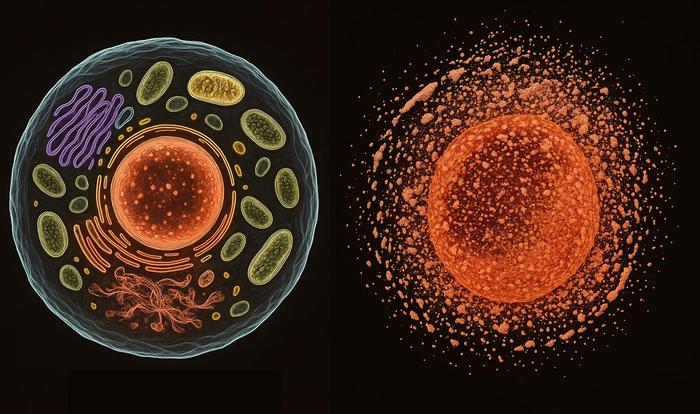In the realm of cellular biology, necrosis has long been painted as a grim biological epilogue — an unregulated form of cell death marked by chaos and destruction. Yet, groundbreaking research emerging from University College London (UCL), LinkGevity, and the European Space Agency (ESA) challenges this perception, unveiling necrosis not merely as a demise but as a potent driver of biological aging and systemic degeneration. Published this year in Nature Oncogene, this study meticulously explores how necrosis, a catastrophic process ignited by infection, injury, or disease, might hold the key to revolutionizing our approach to aging, chronic diseases, and even the future of human spaceflight.
Traditional cell death mechanisms, particularly programmed forms such as apoptosis, are well understood to be tightly regulated, benefiting the organism by removing damaged cells in an orderly, non-inflammatory manner. However, necrosis diverges dramatically from this blueprint. It represents an uncontrolled cellular collapse characterized by membrane rupture and the uncontrolled release of intracellular contents. This spillage triggers heightened inflammation and evokes a ripple effect across neighboring cells and tissues, fundamentally undermining organ function and overall organismal health.
Central to the necrotic cascade is the dysregulation of calcium ion homeostasis. Under normal physiological conditions, calcium concentrations inside the cell are stringently maintained at levels thousands of times lower than those outside, effectively acting as a master regulator that directs signaling pathways critical for cell survival and function. When this delicate equilibrium is lost, an overwhelming surge of calcium floods the cell, akin to an electrical short circuit that disrupts all molecular machinery. This rapid ionic imbalance culminates in necrotic cell death, setting off inflammatory processes and impairing tissue repair mechanisms.
The consequences of necrosis extend far beyond isolated cell death, fostering a self-perpetuating feedback loop of tissue damage and dysfunction. As necrotic cells rupture, they release damage-associated molecular patterns (DAMPs) that recruit immune cells and propagate inflammatory signaling. This chain reaction can accelerate tissue degeneration and underpins the pathology of numerous age-associated diseases including chronic kidney disease, cardiovascular disease, and neurodegeneration such as Alzheimer’s disease.
One striking revelation from the study is the outsized role that necrosis plays in renal health. Kidneys, essential for filtering toxins and maintaining systemic homeostasis, appear particularly vulnerable to necrotic damage induced by diverse stressors such as hypoxia, oxidative stress, and inflammation. Unlike diseases where a singular cause is identifiable, kidney failure hinges on a multifactorial impairment that nonetheless converges onto necrosis as a critical universal mediator. Given that nearly half of individuals by age 75 exhibit some form of nephropathy, addressing necrosis here could transform preventative and therapeutic strategies.
Equally profound are the implications for space travel, where astronauts experience a unique convergence of accelerated biological aging and organ dysfunction. The microgravity environment combined with increased cosmic radiation exposure exacerbates systemic degeneration, with the kidney emerging as a pivotal bottleneck to long-term human survival beyond Earth. This investigation highlights necrosis as both an underlying pathological mechanism and a compelling target for intervention to safeguard astronaut health on protracted extraterrestrial missions.
Experts leading this research underscore that necrosis has been an overlooked frontier in medicine—ignored largely because of its chaotic nature and association with irreversible damage. Yet, emerging evidence posits necrosis as much more than a terminal endpoint; it is a dynamic and central driver of loss of resilience within tissues and organs. The prospect that inhibiting necrotic pathways could interrupt destructive cascades opens unprecedented avenues for promoting regeneration and restoring physiological balance.
From a biochemical standpoint, the orchestration of necrosis centers on the interplay of ion fluxes, mitochondrial dysfunction, membrane integrity failure, and inflammatory signaling pathways. The calcium overload triggers mitochondrial permeability transition, effectively collapsing ATP production and accelerating reactive oxygen species (ROS) generation. This metabolic catastrophe culminates in structural membrane breakdown and cell lysis, releasing intracellular components such as proteases and nucleotides that further damage adjacent cells and fuel inflammation.
Moreover, necrosis-induced inflammation is not a localized phenomenon but a systemic agent of degeneration. This inflammatory milieu promotes fibrosis and scarring, impeding tissue repair mechanisms and exacerbating functional decline. In chronic conditions affecting multiple organs—the lungs, brain, heart, and liver—these pathological circuits become entrenched, progressively overwhelming the body’s capacity for repair and resilience.
The study’s cross-disciplinary nature is noteworthy, bringing together experts from oncology, nephrology, regenerative medicine, and space health. Such collaboration illuminates necrosis’s ubiquity across diverse pathologies and its potential as a unifying therapeutic target. Targeted interventions could involve modulation of calcium channels, stabilization of mitochondrial membranes, or attenuation of inflammatory signaling, aiming not only to halt progression but also to restore cellular homeostasis.
This research thus reframes the dialogue around cell death, advocating for a paradigm shift from viewing necrosis solely as an irreversible evil to recognizing it as a potentially manageable driver of aging and disease progression. The authors propose that by arresting necrosis—even transiently—the body’s intrinsic regenerative processes could regain momentum, transforming the landscape of treatments for age-related diseases and chronic organ failure.
Further exploration into molecular regulators and signaling pathways involved in necrosis may reveal biomarkers for early detection and precision therapies tailored to disrupt necrosis cascades at various stages. This strategy could dramatically improve outcomes in conditions where current treatment options only address symptoms rather than the underlying cellular events.
In summary, the novel insights provided by this study herald a new frontier in biomedicine. Targeting necrosis offers not merely a therapeutic opportunity for improving human healthspan but also addresses critical challenges in extending human presence beyond Earth. By transcending the traditional boundaries of cell death biology, this research lays the groundwork for innovative interventions that could redefine aging, disease management, and space exploration.
Subject of Research: People
Article Title: Necrosis as a fundamental driver of loss of resilience and biological decline: What if we could intervene?
News Publication Date: 29-May-2025
Web References: http://dx.doi.org/10.1038/s41388-025-03431-y
Image Credits: LinkGevity
Keywords: Cell death




